일일커피
모든 것에는 가치가 있다
2019
Category Cafe
Realize Design, Construction, Branding
Completion Date 2019. 02
Location 1F, 59 Jinjae-ro 55beon-gil, Heungeok-gu, Cheongju, South Korea
Photography Park Woo Jin
KR
일일커피는 공간을 새로이 관찰하는 태도로부터 출발한다. 공간의 콘셉트는 ‘모든 것에는 가치가 있다’로, 이곳의 디자인 해법을 설명해주는 중요한 단서가 된다. 사토 다쿠(佐藤卓)의 ‘삶을 읽는 사고’ 라는 책에서는 흔히 디자이너에게 요구되는 자아나 개성과 같은 개념보다는 유연함과 말랑한 소성(塑性)적 사고를 강조한다. 그로부터 영감을 얻어 공간의 컨셉을 ‘모든 것에는 가치가 있다’는 태도로 사물을 바라보는 시각의 다양화, 사고의 전환을 시도해 평범함 속의 특별함을, 익숙한 것 이면의 낯섦을 표현하였다. 하루, 일상, 매일 등 평범하고 흔해서 인지조차 하지 못할 때가 많은 이 의미들이 신선하고도 새로운 무언가를 만들어내 몇몇 강렬한 장면을 연출하기도 한다.
이곳은 주거지역 내에 터를 잡고 있다. 그렇다면 그 환경에서 익숙하고 평범한 풍경은 무엇일까. 바로 집이 아닐까? 그러한 연상을 통해 집에서 흔히 보고 접하는 소파, 커튼, 테이블 등을 의외성을 띠는 소재로 묘사함으로써 ‘모든 것에는 가치가 있다’는 콘셉트를 전개했다. 내부의 콘크리트 벤치는 벽을 등진 채 놓은 거실의 소파를 연상케 하며, 물결처럼 완곡한 굴곡을 뽐내는 목재벽은 커튼의 주름을 보는 듯하다. 또한, 모카포트를 가스레인지로 가열하는 커피 추출 방식은 주방의 낯익은 환경을 연출하고, 식탁의 역할이 그러하듯 바리스타와 고객이 소통할 수 있는 커피바로 변신했을 때 화병의 꽃, 식재와 돌 등 자연물을 배치해 그 상징성을 더욱 도드라지게 만들었다. 평범하고 흔한 소재를 통한 새로운 디자인 방식은 주차장의 고깔, 콘크리트를 배합하는 미장통을 거푸집으로 활용해 색다를 해석을 시도한 독특한 형태감의 테이블로 보다 극대화된다. 이와 같은 사고의 전환으로 일일커피는 고유의 아이덴티티를 확고히 하고자 했다.
전체를 조망했을 때는 경계가 허물어진 구조를 띤다. 자갈처럼 보이는 파쇄석이 내외부를 이어주는 주요한 장치로 작용하며 구분을 모호하게 만들었고, 기존 건물의 많은 부분을 그대로 품어 수용하고 흡수하는 복합적인 디자인으로 사용자의 경계심을 무너뜨리고자 했다. 이 과정에는 기존의 것을 가치있게 바라보며 가져갈 것과 덜어낼 것을 선별하는 과정이 선행되었다. 즉 일일커피의 모호한 경계가 조성된 데에는 공간 구조뿐만 아니라 기존의 것을 받아들이는 반면, 그에 맞춰 새로운 것을 더한다는 개념이 존재한다고 봐도 무방할 듯하다. 결국 이 모든 것이 가리키는 바는 넌지시 보았을 때 낯선 기분은 의외로 익숙함에서 비롯되었다는 것이다. 가치의 재발견을 통해 평범함을 낯섦으로, 일상을 새로움으로 해석하고 디자인한 방식은 일일커피가 지향하는 ‘모든 것에는 가치가 있다’는 사고를 보여주며 그 가능성을 확장한다.
EN
‘ilil coffee’ starts from a perspective of reobserving space. The concept “Everything has value” provides an important clue to understanding the design approach here. In Taku Sato’s book “Thinking that Reads Life,” he emphasizes flexibility and soft plasticity over concepts like individuality and personality often required of designers. Inspired by this, the space’s concept tries to diversify perspectives and shift thinking to see the special in the ordinary and the unfamiliar in the familiar. The idea that everyday elements like a day, a routine, and the daily grind can create fresh and new scenes is explored.
Located in a residential area, the familiar and ordinary landscape here is the home. By depicting common household items like sofas, curtains, and tables with unexpected materials, the concept of “everything has value” is expanded. The concrete bench inside the space evokes a living room sofa against the wall, and the undulating wooden wall mimics the folds of a curtain. The method of extracting coffee by heating a moka pot on a gas stove recreates the familiar kitchen environment, and placing natural elements like flowers and stones around the coffee bar emphasizes its symbolism when it transforms into a communication space between the barista and customers. Using ordinary materials in new ways is further exemplified by the unique tables made from parking cones and mixing tubs used as molds.
From a broader perspective, the space has a boundary-less structure. The crushed stones that look like gravel connect the interior and exterior, blurring the lines and incorporating many elements of the existing building to break down users’ defenses with a composite design. This process involved valuing the existing elements and selectively retaining or removing them. This blurred boundary is not just a structural aspect but also an acceptance of the old and an addition of the new. Thus, the unfamiliar feelings that arise subtly stem from familiarity. By rediscovering value, the ordinary becomes unfamiliar, and the routine becomes new, illustrating ‘ilil coffee”s philosophy that “everything has value” and expanding its possibilities.
Sketch
ilil coffee's perspective proposal
Property of the atmoround
Drawn: atmoround
©2018 ATMOROUND

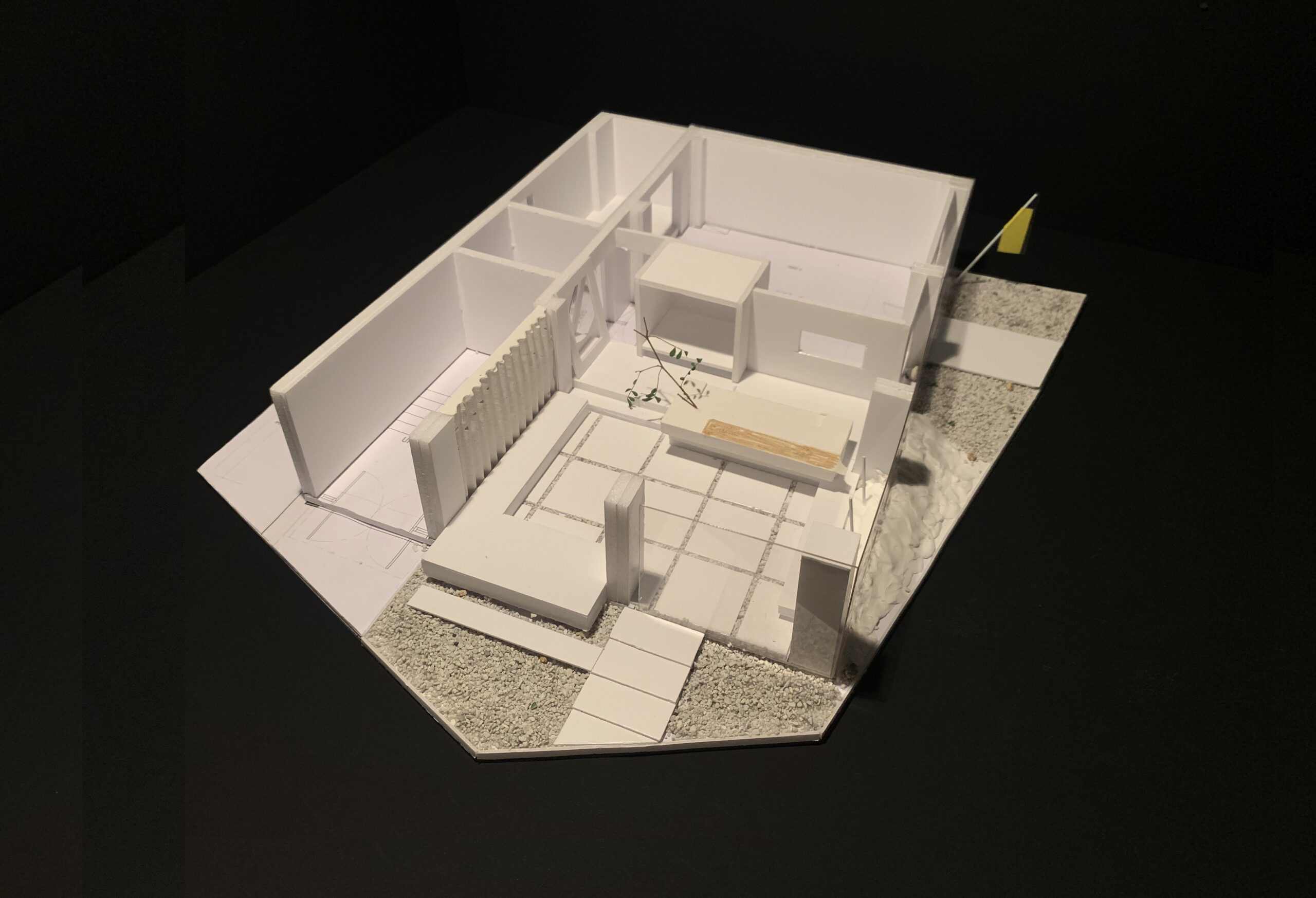
Model
Studymodel for 'ilil coffee'
Property of the atmoround
Made: atmoround
©2018 ATMOROUND
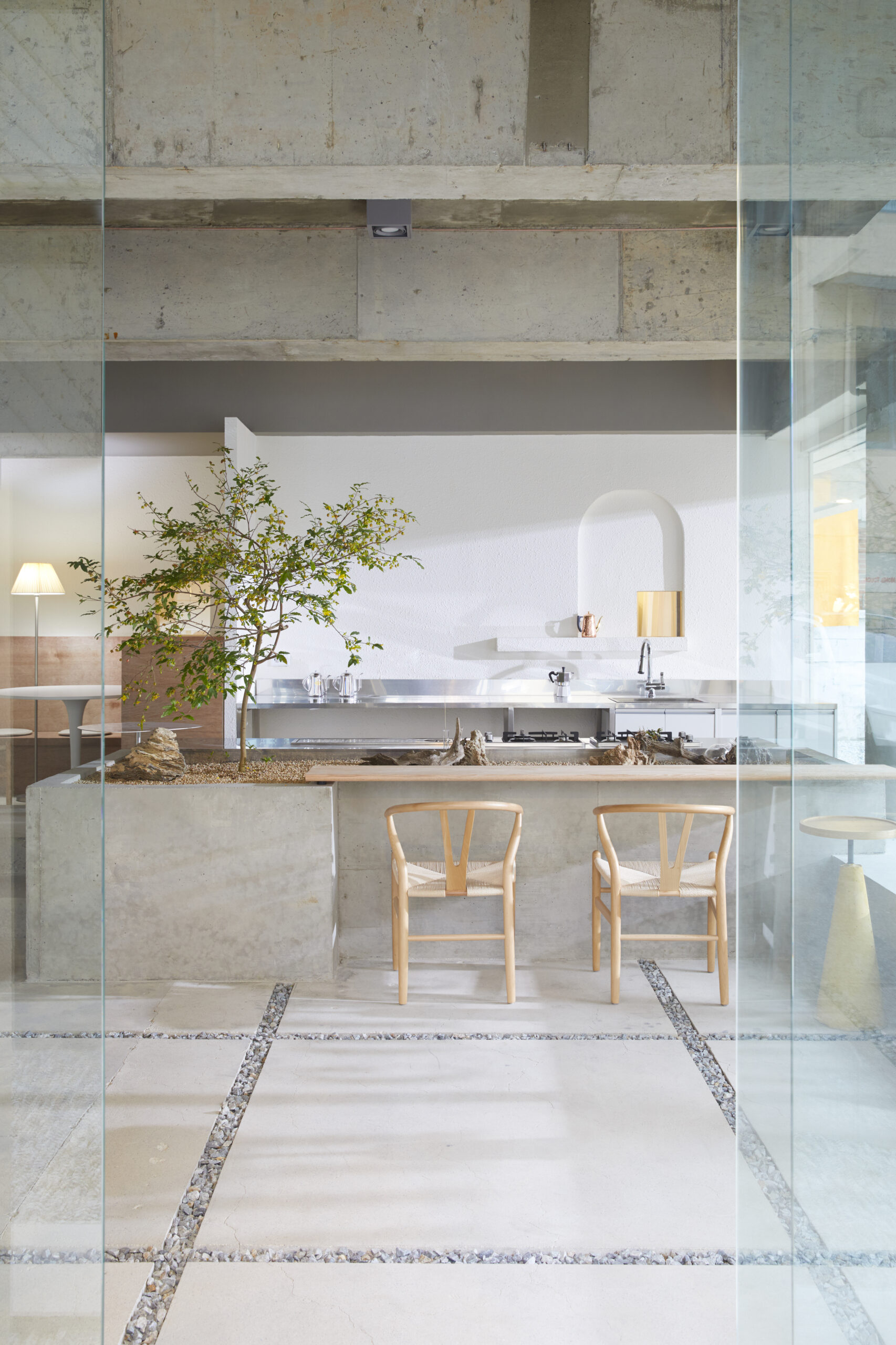
Photo
The coffee bar (that greets you when you first enter) was designed to act as a dinner table where baristas can communicate with their customers.
Photo: Park Woo Jin
©2019 ATMOROUND
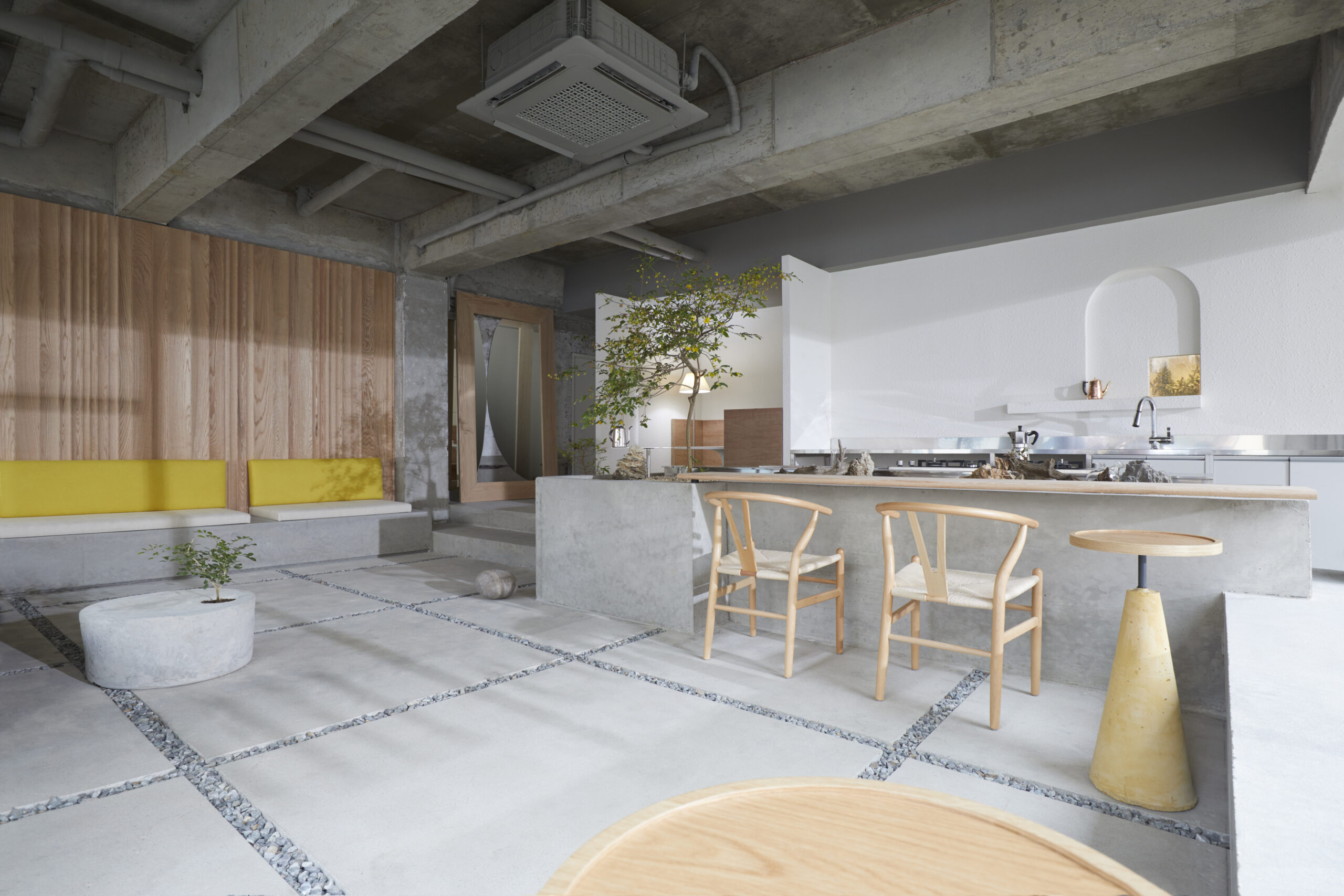
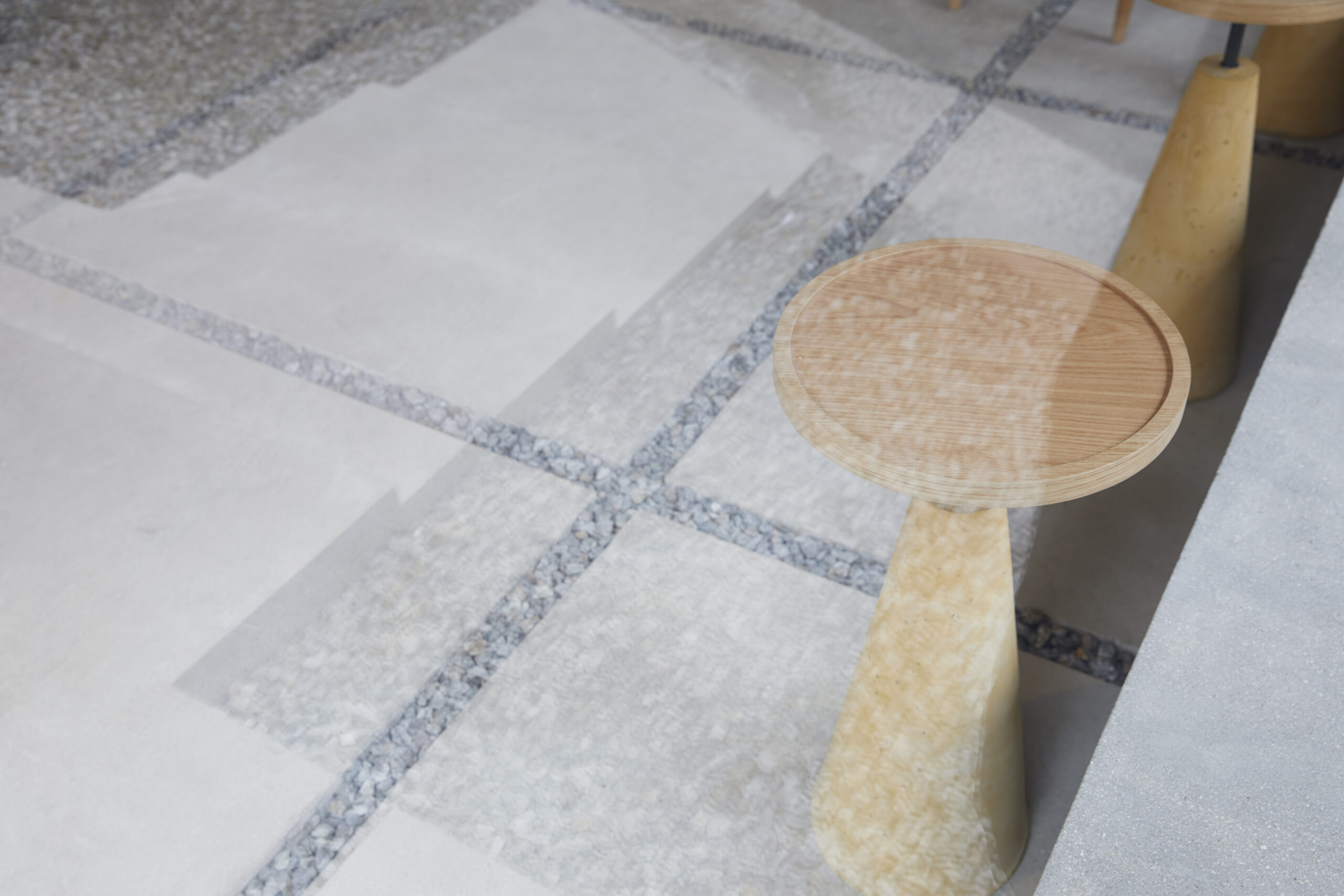
Photo
Crushed stones were used both inside and outside; this provides a cohesiveness to the design where inside feels like outside and vice versa.
Photo: Park Woo Jin
©2019 ATMOROUND
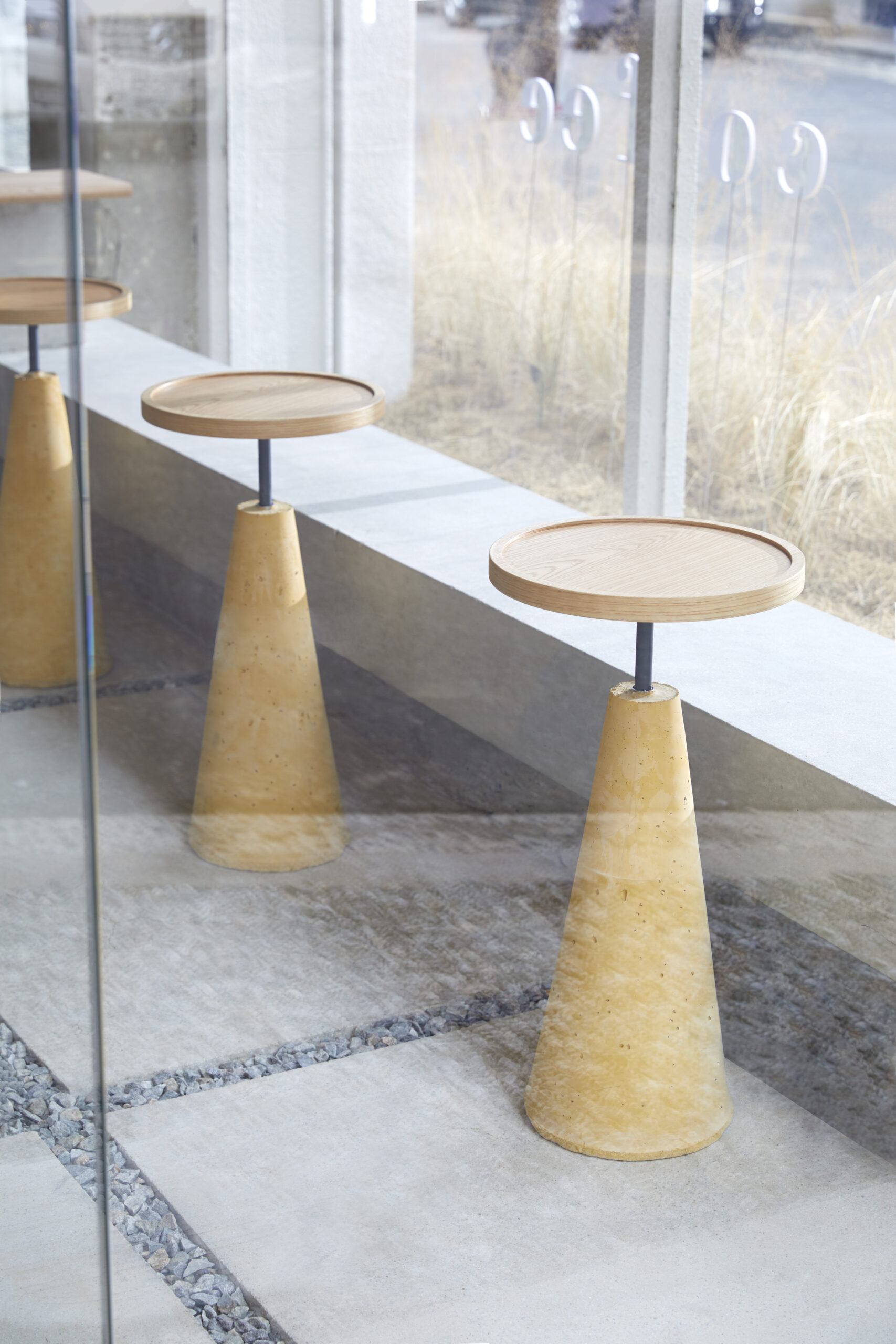
Photo
The yellow flat-top cone shaped table is also one of the examples of seeing the essence of things rather than being confined to its original usage.
Photo: Park Woo Jin
©2019 ATMOROUND
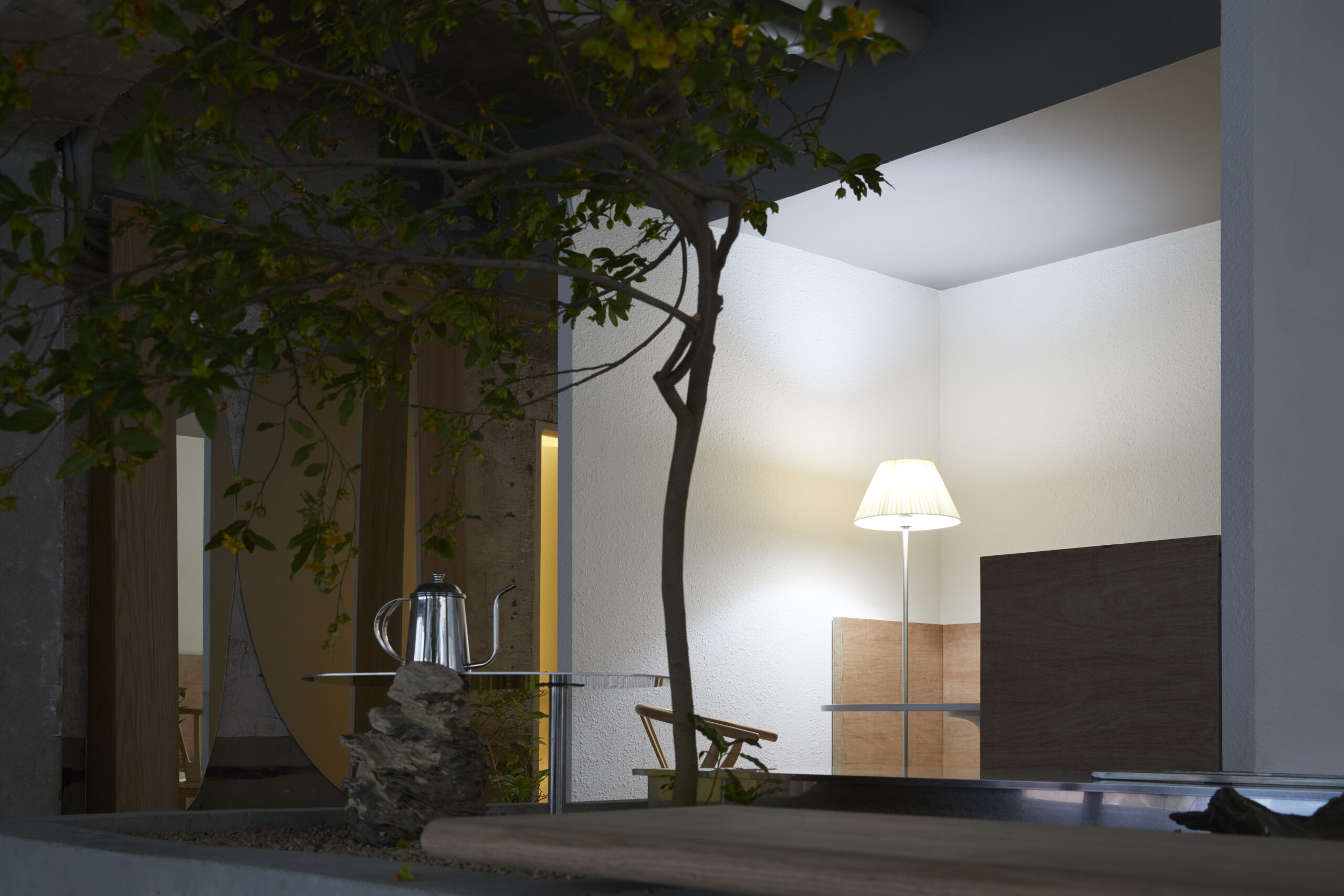
Photo
In the middle of the table where the work table and the bar meet is the gravel-filled middle space decorated with flowers and a small tree.
Photo: Park Woo Jin
©2019 ATMOROUND

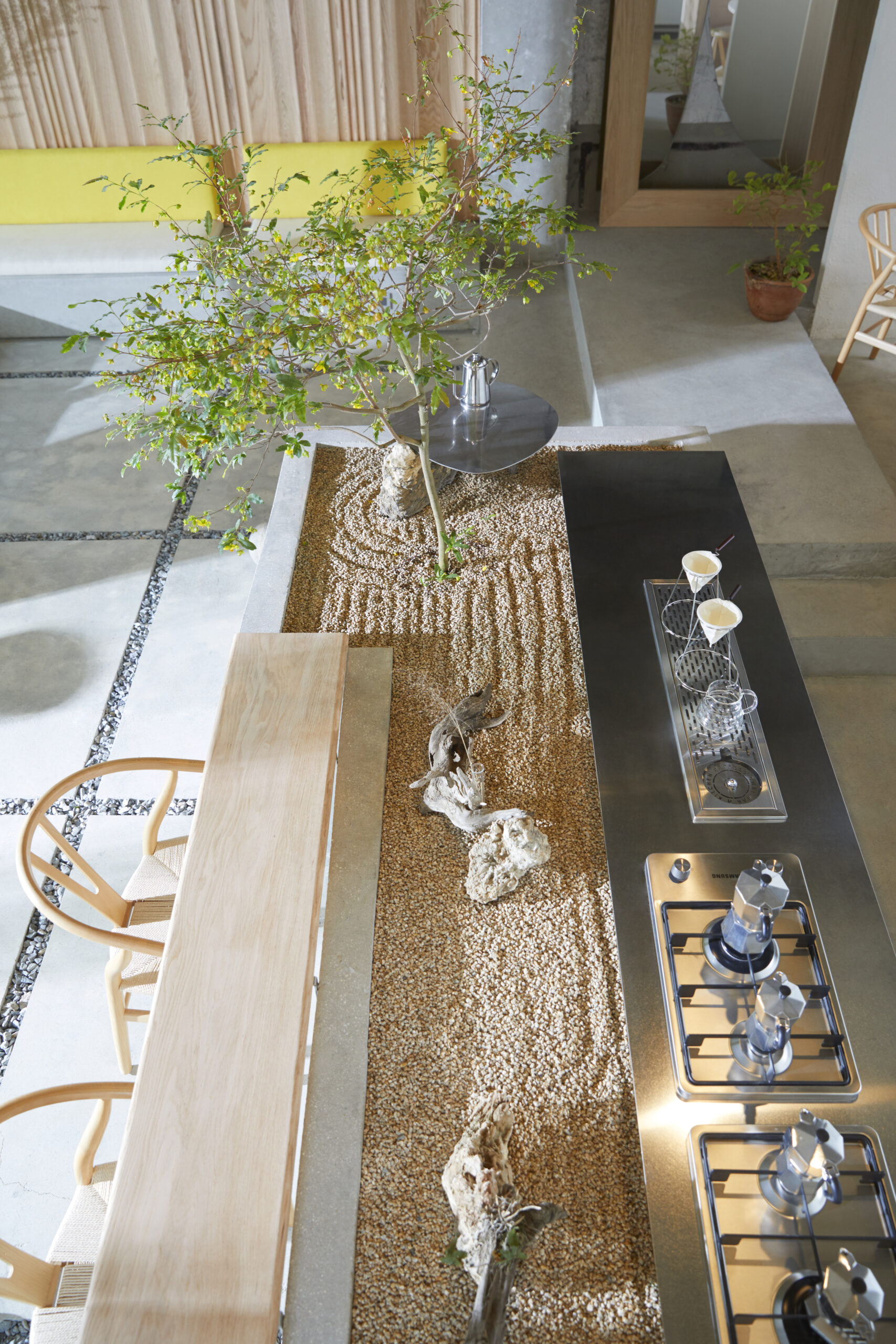
Photo
The coffee maker, Moka pot, is placed on the stove in front of the table for customers to see how things they used in their homes can be used in other ways.
Photo: Park Woo Jin
©2019 ATMOROUND
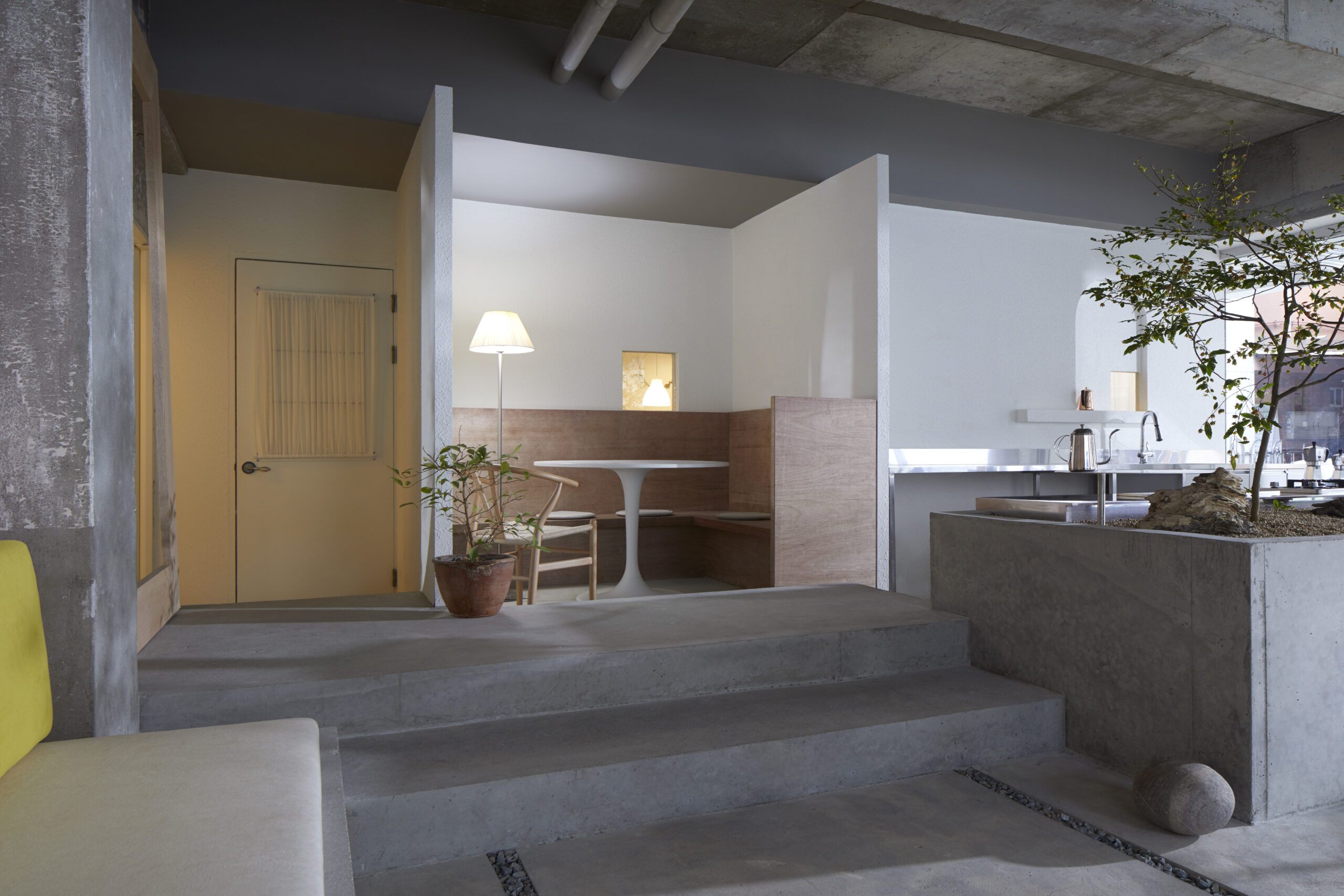
Photo
Beside the main bar, there is a space designed to be cozy and partitioned, as if it were a room with a window.
Photo: Park Woo Jin
©2019 ATMOROUND

Photo
Designed as if it were a room with a window, the booth sofa zone's window allows you to see the lighting of the back store, also operated by the client.
Photo: Park Woo Jin
©2019 ATMOROUND

Photo
The wall mirrors reinterpret everyday life by attaching the mirror to the wall and leaning the frame against it, creating a fresh and unique look.
Photo: Park Woo Jin
©2019 ATMOROUND
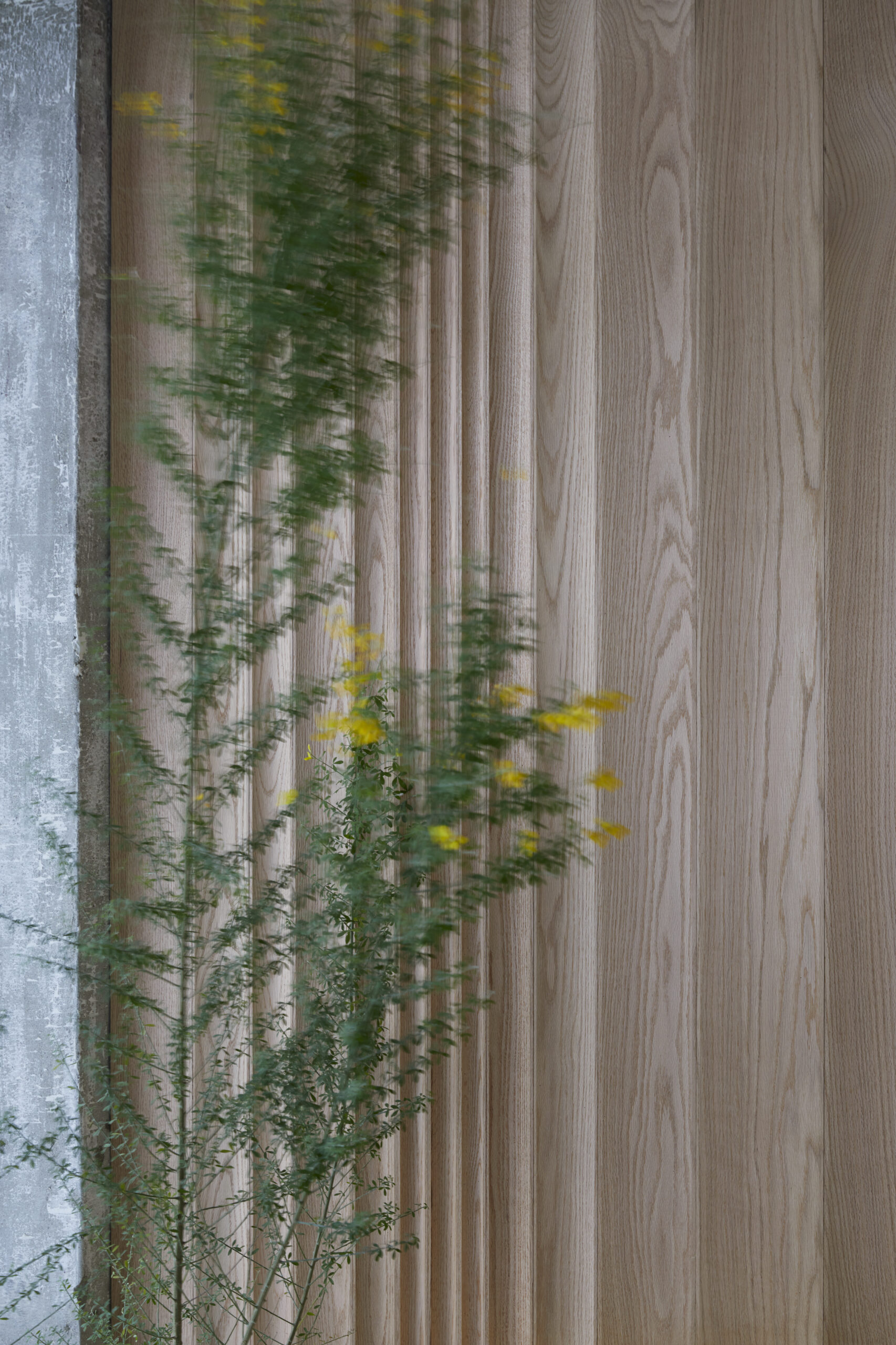
Photo
We are replacing the curtain with the wooden molding added a fun twist to the space.
Photo: Park Woo Jin
©2019 ATMOROUND
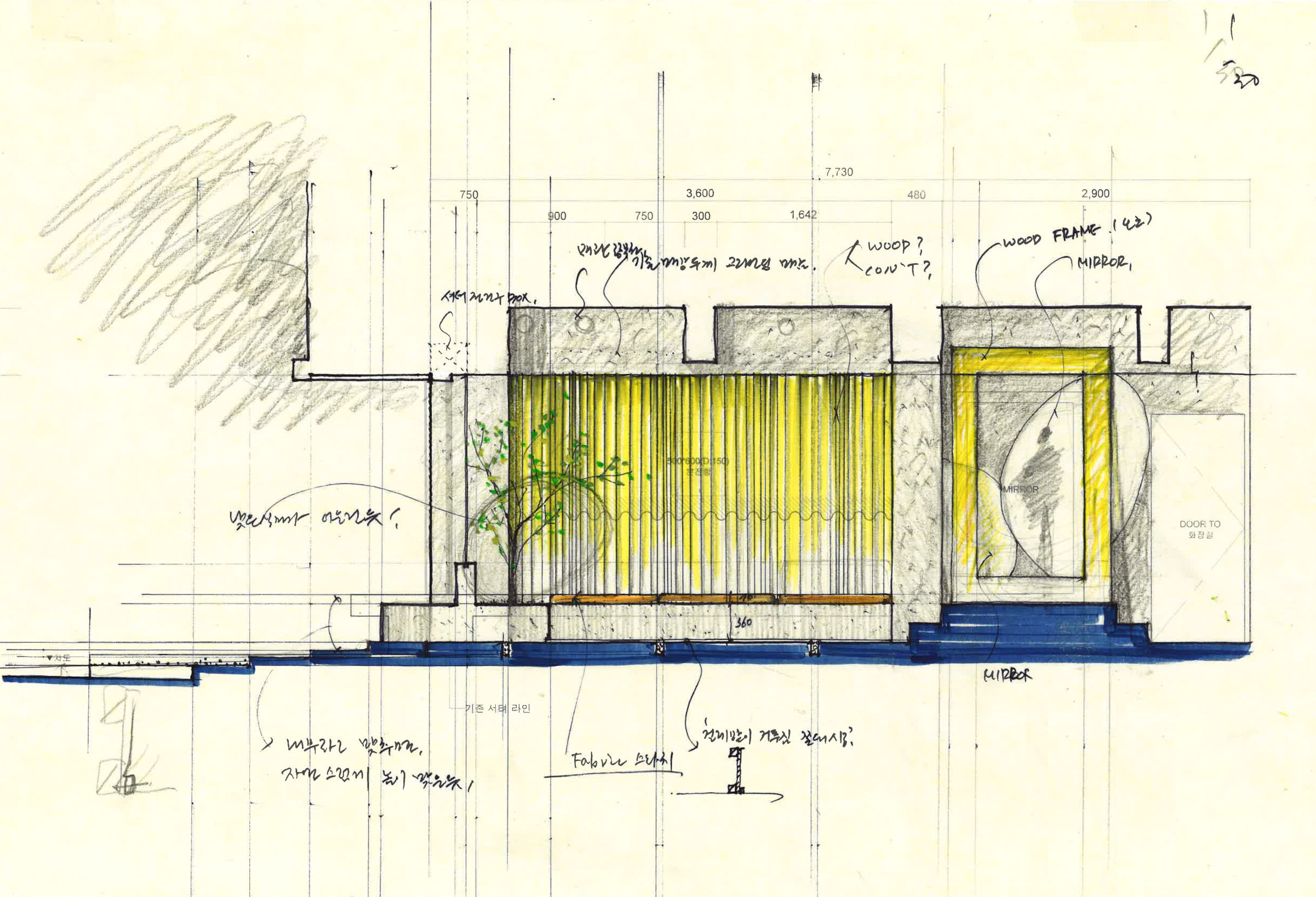
Sketch
Elevation sketch : An unfamiliar mirror and Curtain.
Property of the atmoround
Drawn: atmoround
©2018 ATMOROUND
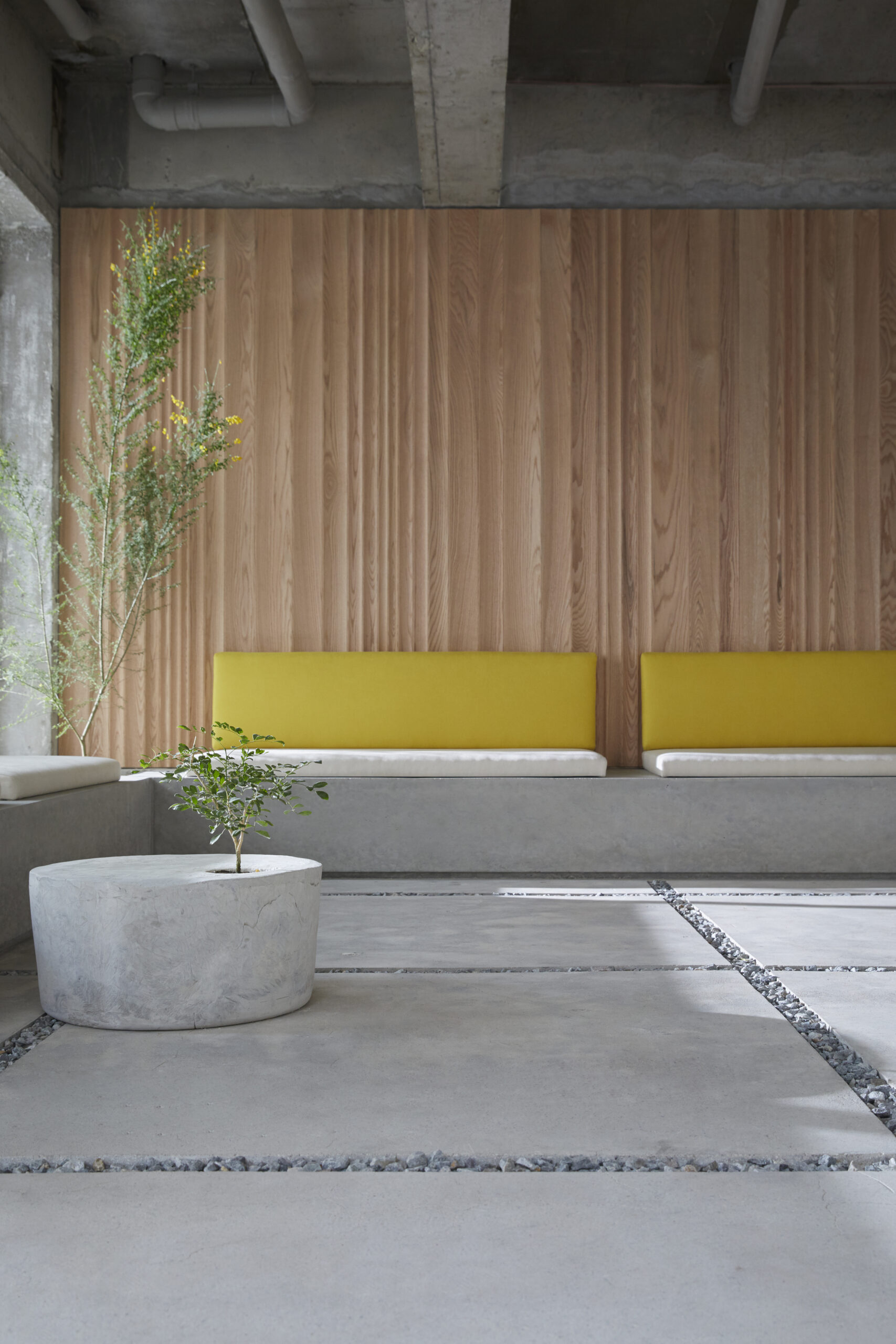
Photo
The sofa was arranged against the wall, facing the wide living space as in most of the Asian houses. However, by having the sofa made of hard concrete with cushions for comfortable sitting and replacing the curtain with the wooden molding .
Photo: Park Woo Jin
©2019 ATMOROUND

Photo
The round concrete table was made using mixing plastic tubs as molds for pouring the concrete. This material was reinterpreted from its original function to serve as a table.
Photo: Park Woo Jin
©2019 ATMOROUND
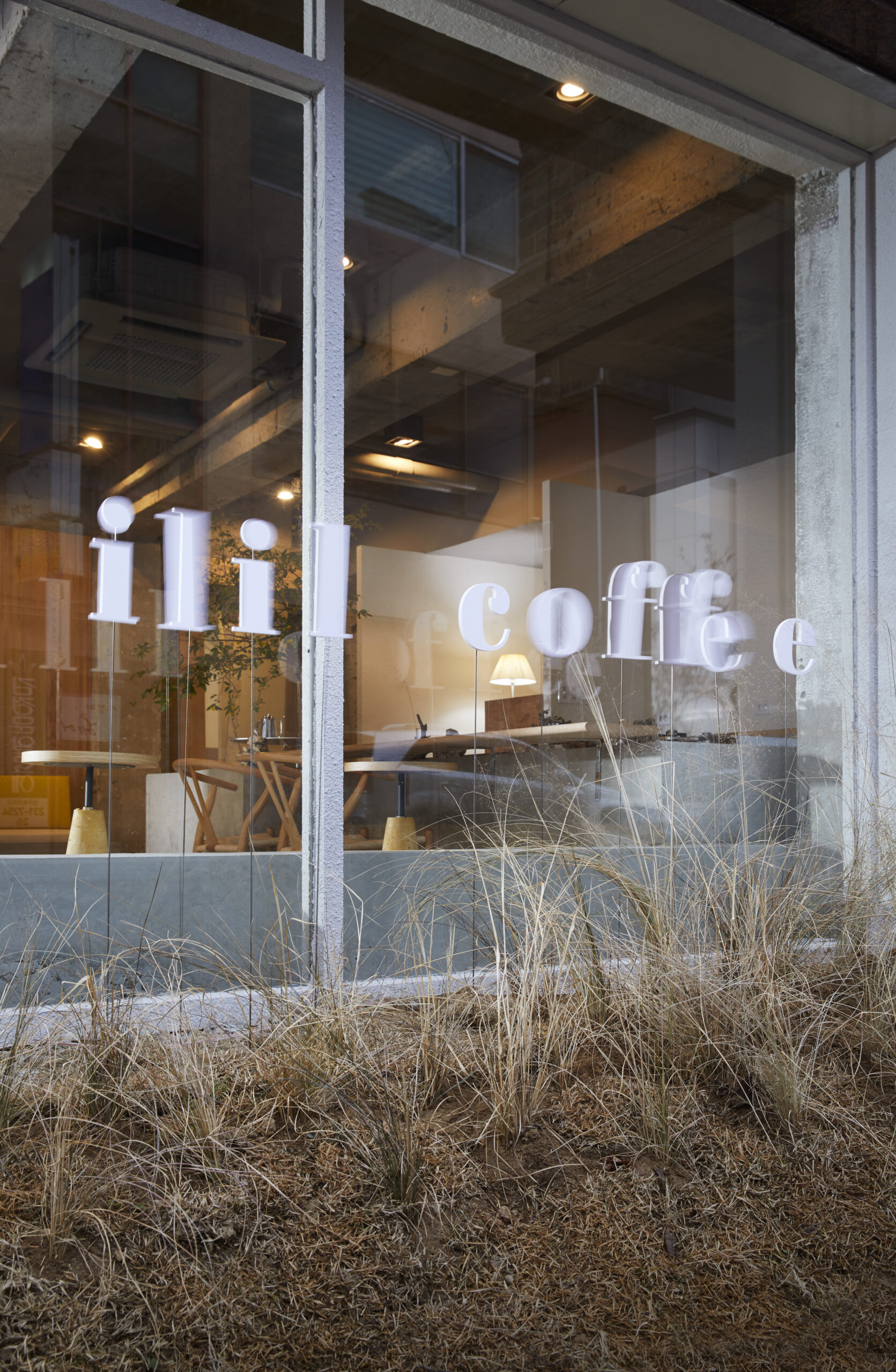
Photo
A moving sign designed to express the breeze of everyday life: What appears to be new and unfamiliar methods are, upon closer inspection, familiar everyday elements.
Photo: Park Woo Jin
©2019 ATMOROUND
Category Cafe
Realize Design, Construction, Branding
Completion Date 2019. 02
Location 1F, 59 Jinjae-ro 55beon-gil, Heungeok-gu, Cheongju, South Korea
Photography Park Woo Jin
KR
일일커피는 공간을 새로이 관찰하는 태도로부터 출발한다. 공간의 콘셉트는 ‘모든 것에는 가치가 있다’로, 이곳의 디자인 해법을 설명해주는 중요한 단서가 된다. 사토 다쿠(佐藤卓)의 ‘삶을 읽는 사고’ 라는 책에서는 흔히 디자이너에게 요구되는 자아나 개성과 같은 개념보다는 유연함과 말랑한 소성(塑性)적 사고를 강조한다. 그로부터 영감을 얻어 공간의 컨셉을 ‘모든 것에는 가치가 있다’는 태도로 사물을 바라보는 시각의 다양화, 사고의 전환을 시도해 평범함 속의 특별함을, 익숙한 것 이면의 낯섦을 표현하였다. 하루, 일상, 매일 등 평범하고 흔해서 인지조차 하지 못할 때가 많은 이 의미들이 신선하고도 새로운 무언가를 만들어내 몇몇 강렬한 장면을 연출하기도 한다.
이곳은 주거지역 내에 터를 잡고 있다. 그렇다면 그 환경에서 익숙하고 평범한 풍경은 무엇일까. 바로 집이 아닐까? 그러한 연상을 통해 집에서 흔히 보고 접하는 소파, 커튼, 테이블 등을 의외성을 띠는 소재로 묘사함으로써 ‘모든 것에는 가치가 있다’는 콘셉트를 전개했다. 내부의 콘크리트 벤치는 벽을 등진 채 놓은 거실의 소파를 연상케 하며, 물결처럼 완곡한 굴곡을 뽐내는 목재벽은 커튼의 주름을 보는 듯하다. 또한, 모카포트를 가스레인지로 가열하는 커피 추출 방식은 주방의 낯익은 환경을 연출하고, 식탁의 역할이 그러하듯 바리스타와 고객이 소통할 수 있는 커피바로 변신했을 때 화병의 꽃, 식재와 돌 등 자연물을 배치해 그 상징성을 더욱 도드라지게 만들었다. 평범하고 흔한 소재를 통한 새로운 디자인 방식은 주차장의 고깔, 콘크리트를 배합하는 미장통을 거푸집으로 활용해 색다를 해석을 시도한 독특한 형태감의 테이블로 보다 극대화된다. 이와 같은 사고의 전환으로 일일커피는 고유의 아이덴티티를 확고히 하고자 했다.
전체를 조망했을 때는 경계가 허물어진 구조를 띤다. 자갈처럼 보이는 파쇄석이 내외부를 이어주는 주요한 장치로 작용하며 구분을 모호하게 만들었고, 기존 건물의 많은 부분을 그대로 품어 수용하고 흡수하는 복합적인 디자인으로 사용자의 경계심을 무너뜨리고자 했다. 이 과정에는 기존의 것을 가치있게 바라보며 가져갈 것과 덜어낼 것을 선별하는 과정이 선행되었다. 즉 일일커피의 모호한 경계가 조성된 데에는 공간 구조뿐만 아니라 기존의 것을 받아들이는 반면, 그에 맞춰 새로운 것을 더한다는 개념이 존재한다고 봐도 무방할 듯하다. 결국 이 모든 것이 가리키는 바는 넌지시 보았을 때 낯선 기분은 의외로 익숙함에서 비롯되었다는 것이다. 가치의 재발견을 통해 평범함을 낯섦으로, 일상을 새로움으로 해석하고 디자인한 방식은 일일커피가 지향하는 ‘모든 것에는 가치가 있다’는 사고를 보여주며 그 가능성을 확장한다.
EN
‘ilil coffee’ starts from a perspective of reobserving space. The concept “Everything has value” provides an important clue to understanding the design approach here. In Taku Sato’s book “Thinking that Reads Life,” he emphasizes flexibility and soft plasticity over concepts like individuality and personality often required of designers. Inspired by this, the space’s concept tries to diversify perspectives and shift thinking to see the special in the ordinary and the unfamiliar in the familiar. The idea that everyday elements like a day, a routine, and the daily grind can create fresh and new scenes is explored.
Located in a residential area, the familiar and ordinary landscape here is the home. By depicting common household items like sofas, curtains, and tables with unexpected materials, the concept of “everything has value” is expanded. The concrete bench inside the space evokes a living room sofa against the wall, and the undulating wooden wall mimics the folds of a curtain. The method of extracting coffee by heating a moka pot on a gas stove recreates the familiar kitchen environment, and placing natural elements like flowers and stones around the coffee bar emphasizes its symbolism when it transforms into a communication space between the barista and customers. Using ordinary materials in new ways is further exemplified by the unique tables made from parking cones and mixing tubs used as molds.
From a broader perspective, the space has a boundary-less structure. The crushed stones that look like gravel connect the interior and exterior, blurring the lines and incorporating many elements of the existing building to break down users’ defenses with a composite design. This process involved valuing the existing elements and selectively retaining or removing them. This blurred boundary is not just a structural aspect but also an acceptance of the old and an addition of the new. Thus, the unfamiliar feelings that arise subtly stem from familiarity. By rediscovering value, the ordinary becomes unfamiliar, and the routine becomes new, illustrating ‘ilil coffee”s philosophy that “everything has value” and expanding its possibilities.